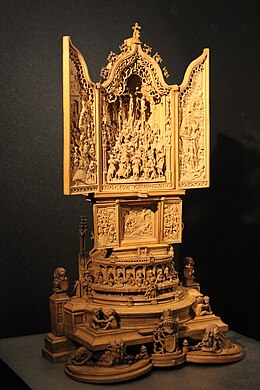
Adam Dircksz (active 1500–1530)[1] is the name ascribed by some art historians to a highly influential Dutch sculptor whose workshop is often attributed with the creation of around 60[1] of the c. 150 extant Gothic boxwood miniature micro-carvings. Other historians prefer to attribute various unrelated artists who are given individual or grouped notnames. It may be that the master was the innovator in this style of sculpture, and that similar works were directly inspired. According to the British Museum, Dircksz may have served "elite patrons in the circle of the Holy Roman Emperor Charles V, with a strong link to Delft."[1]
Almost nothing is known about his life, except from some dates and signatures left on carvings, which indicate only that he was associated with the art works, the real life person may have been a woodcutter, sculptor, medallist, or a patron.[1] Dircksz is thought to have been active between 1500 and 1530, and responsible for some sixty of the surviving examples.[1] He may have led a workshop in the southern Netherlands,[2] given that Flemish inscriptions appear on some of the carvings.[3] Alternatively, it was located more northerly, possibly in the north of Brabant or at Delft in Holland.[4] In any case, apart from Henry VIII and Catherine, all of the original owners come from the Netherlands.[5]
- ^ a b c d e "Adam Dircksz (Biographical details)". British Museum. Retrieved 18 November 2018
- ^ Shaw, Tamsin. "The Universe in a Nutshell". The New York Review of Books, 12 May 2017. Retrieved 8 October 2018
- ^ Wixom (1983), p. 43
- ^ Scholten (2011), p. 342
- ^ Marks (1977), p. 141